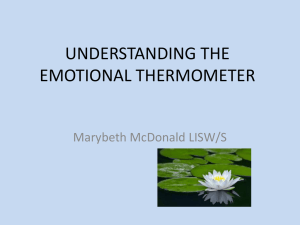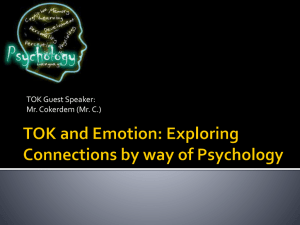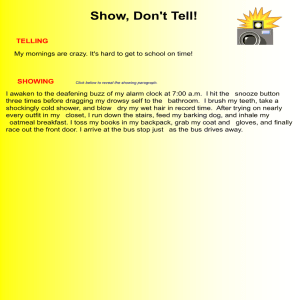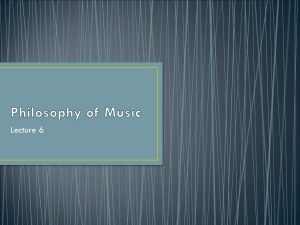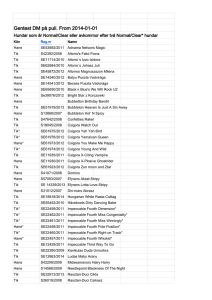here - Australian Psychological Society
advertisement
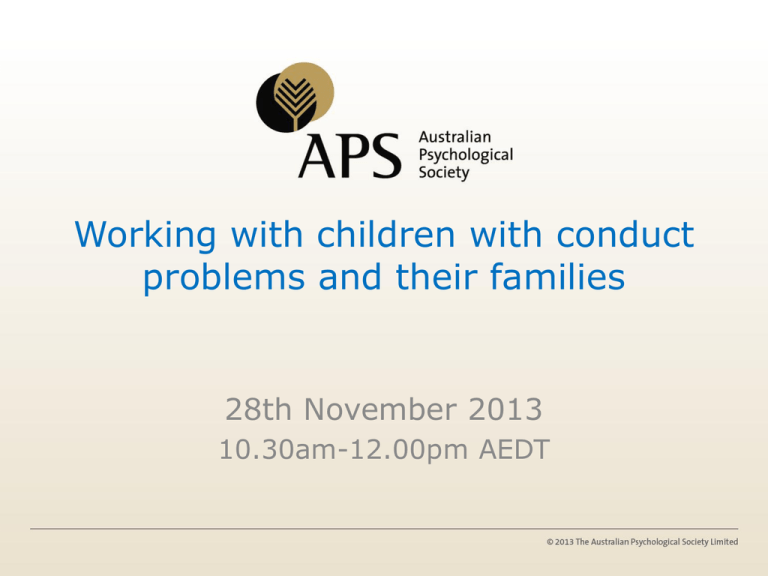
Working with children with conduct problems and their families 28th November 2013 10.30am-12.00pm AEDT PRESENTERS: Professor Mark R Dadds Director of the Child Behaviour Research Clinic, Professor of Psychology, University of New South Wales Dr Sophie Havighurst Senior Lecturer and Clinical Psychologist University of Melbourne Facilitator: Bella Saunders, Senior Psychologist APS Love and eye contact in the aetiology and treatment of early-onset conduct problems. Mark R Dadds problems? Why study conduct problems? Conduct disorders & operant/attachment theory My experience of 20 years of Child & Family CBT • • • • • -Triple P -Move from single techniques to “big” therapies -Manuals and commercial dissemination -Everything works at about 50% -Can we learn from our failures? Aims Design assessments and interventions that are sensitive to child–specific ‘causal’ variables. Heterogeneity in conduct problem children Hot CD – emotional/anxious - high susceptability to environments - “normal aggression”. Cold CD- callous/unemotional (measured through parent-teacher report) - low susceptability to environment - “abnormal aggression.” Viding, Blair, Moffitt & Plomin (2005) Proband m ean (SD ) C o-tw in T ransform ed co-tw in m ean (SD ) m ean 2 2 hg cg a) E xtrem e antisocial behaviour in children w ithout psychopathic tendencies (N ¼ 210) M Z tw ins 2.02 (.62) D Z tw ins 2.15 (.88) 1.29 (1.24) 1.05 (1.66) .64 .49 .30 (-.10–.70) .34 (-.40–1.08) .73 .39 .67 (.47–.87) .06 (-.23–.35) b) E xtrem e callous-unem otional M Z tw ins (N = 612) M Z tw ins 1.79 (.56) D Z tw ins 1.80 (.57) 1.30 (.96) .71 (1.05) c) E xtrem e antisocial behaviour in children w ith psychopathic tendencies (N = 234) M Z tw ins 2.82 (1.13) D Z tw ins 2.81 (1.26) 2.15 (1.52) 1.00 (1.72) .76 .36 .81 (.50–1.12) ) .05 (.00–.72) Attention in emotion processing Increasing evidence that various forms of psychopathology are associated with deficits in processing emotions Relevant genotypes differently associated with amygdala activity to threatening faces Psychopathy associated with specific deficits in fear recognition and low amygdala response Anxiety/depression/hot aggression associated with increased fear recognition and high amygdala response Correlations between CU, Antisocial and accuracy of emotion recognition Dimension CU traits Antisocial Partial Correlation 0.20 0.00 -0.20 -0.40 -0.60 happy sad angry fear disgust neutral Emotion Dadds MR et al (2006). Look at the eyes: Fear recognition in child psychopathy. British Journal of Psychiatry, 189, 180-181. Munoz et al (2009) Journal of the American Academy of Child & Adolescent Psychiatry, 48, 5 554-562 Blair et al (2002) – vocal cues. Language of the eyes (super-stimuli) • Amygdala and attention, social gaze • Ralph Adolph’s work Idea 1: Fear perception and theory of mind Fear stimulus Aversive threat Information about environment from following other’s gaze Observer Mean accuracy of facial fear recognition for boys high and low on CU traits under three Gaze conditions: no instruction, instruction to focus on eyes, instructed to focus on mouth. Significant interaction between Gaze and CU category, F(2,55) = 5.149, p =.009. Error bars represent standard errors of the mean. 2.0 CU category Low A cc ur ac y 1.8 1.5 High 1.3 1.0 Free Eyes Gaze Mouth Eye Gaze Hotspots Healthy boys “Cold’ conduct problems Dadds et al. (2008) J Amer Acad Child Adolesc Psych. Hi CU boys So? Does it happen in the real world? With attachment figures? Example visual scan-paths and fixation time summaries for 3 toddlers watching the same video of an actress playing the role of a caregiver Jones, W. et al. Arch Gen Psychiatry 2008;65:946-954. Copyright restrictions may apply. Study 1: But......... •No control group •Age spread •Expensive coding •Inappropriate tasks •And….WARMTH! Study 2: Method • Participants • N = 24 children between 3 and 8 years of age; • n = 12 with Oppositional Defiant Disorder (ODD) • n = 12 comparison group. • The LOVE interaction The Eye-Love-You Game Healthy dyad: The Eye-Love-You Game Interpretations 1. Low eye contact is just another marker of low empathy 2. Low eye contact drives the development of low empathy and low susceptibility to parenting 3. Arguments: 1. Shaw et al (2005) – early versus late amygdala damage 2. The primacy of parent-child eye contact 3. Newman et al. And Dadds et al. on attentional manipulations OXYTOCIN Oxytocin ......... “who’s important to me, who I’d die for, who I’m pairbonded with, who will take care of me,” (Thomas Insel) Oxytocin and vasopressin levels after interaction with mothers Reading the Mind in the Eyes Test jealous arrogant panicked hateful Guastella A, Dadds MR, & Mitchell PB. (2009) Oxytocin increases gaze to the eye-region of human faces. Biological Psychiatry. Conclusions: • CU traits are associated with an impairment in attention to emotional cues: These cues usually function as “super-stimuli” through development, provoking and consolidating important neural system that scaffold the development of affective contagion through to empathic concern; An error that in the system driving attention to these stimuli could lead to cascading errors across the development of empathic concern; While we cannot exclude environmental input, this impairment in the attachment system - genetic and epigenetic variations in the oxytocin receptor system. OXT (/SERT) systems Attention to emotional stimuli Quality of parenting reciprocated love Pubertal transition Contagious affect Moral conscience Implications for future treatments Specific parenting strategies need to be refined in terms of specific emotional attention proclivities of the child. e.g. Eye contact with “hot” versus “cold problem children Behavioural experiments with eye contact (love and attachment) Emotion attention/recognition training Biobehavioural manipulations of the OXT system Dadds, Cauchi, Wimalaweera, Hawes, & Brennan. Psychiatry Research (in press). Thanks to Sydney: David Hawes, John Brennan, Caroline Moul, Subodha Wimmalaweera, Dave Pasalich, Jasmin Jambrak, Avril Cauchi London: Stephen Scott, Jen Allen, Bonamy Oliver, Nathan Faulkner, Kat Legge, Caroline Moul, Matt Woolgar Thank YOU! Working with Children with Conduct Problems: The Tuning in to Kids program Dr Sophie Havighurst Written by Sophie Havighurst and Ann Harley www.tuningintokids.org.au Overview of Tuning in to Kids Tuning in to Kids (TIK) is an evidencebased program that helps parents teach their children about emotions while building a close and supportive relationship. What is the TIK program? • • • • • • Six session, parenting group program Focus on emotions in parents and children Parents become aware of their child’s emotions and coach their child in being able to understand and regulate emotions Parents become aware of and regulate their own emotions when parenting In children - prevents problems from developing, or reduces problems that exist Can be used in individual therapy Theoretical Basis •Based on the theory about the role of parent emotion socialization practices in shaping children’s emotional and behavioural competence. •Targets emotional communication in parentchild relationships •Draws on aspects of social learning theory, attachment theory, mindfulness and emotion coaching Emotion Coaching To emotion coach your child you: • Become aware of their emotion, especially if it is of a lower intensity (such as disappointment or frustration) • View their emotion as an opportunity for intimacy and teaching • Communicate your understanding and acceptance of the emotion – empathy • Help them use words to describe what they feel • If necessary, help them to solve problems. You may also communicate that all wishes and feelings are acceptable, but some behaviours are not. Adapted from Gottman, J. M. & DeClair, J. (1997). The Heart of Parenting: Raising an Emotionally Intelligent Child. New York: Simon & Schuster. TIK Theoretical Model Tuning in to Kids Program Social/Cultural Factors Family of Origin experience with emotion Parent MetaEmotion Philosophy Child Factors •Temperament •Neurophysiology •Gender •Cognition/language Parent Functioning •Emotion awareness •Emotion wellbeing Family Functioning: •Emotion climate Child Emotion Competence •Emotionality •Emotion Regulation •Emotion Knowledge Parenting: •Attitudes/beliefs •Emotion coaching •Mindfulness •Responsiveness Child Outcomes •Behaviour •Social Skills •Academic •Health Why TIK with children with behaviour problems? • • • • • • Diverse approaches are needed Strategies for increasing attachment and building close connections between parents and children Assist parents to shift from automatic patterns in parenting Put developmental theories about emotional intelligence/competence into action Understand the emotional needs that lie behind challenging behaviours A complement for behavioural techniques (such as Triple P) or a different approach altogether. TIK Research Evidence Research on TIK and program variants Tuning in to Toddlers • Pilot study (2010-2012) - MA student Michelle Lauw TIK Preschool Research Studies: • pilot study (2000-2002) • RCT community efficacy trial (2006-2009) • Case studies with anxious children (2008-2010) – PhD student Galit Hasen • RCT clinical efficacy trial (2006-2009) • RCT community effectiveness trial (2010-2011) • DADS TIK pilot study (2011) • DADS TIK RCT efficacy trial – (2012-2014) TIK School Aged Research Studies • RCT with conduct problem children - CASEA (2008-2013) - PhD student Melissa Duncombe • RCT clinical sample children with chronic illness (2012-2014) - PhD student Wai Wai Yang • Trauma-focused pilot study (2009-2013) - with Australian Childhood Foundation Tuning in to Teens – Pre-adolescents and adolescents • TINT (pre-adolescent) pilot study (2007) • TINT (pre-adolescent) efficacy trial – RCT (2009-2012) – PhD student Christiane Kehoe • TINT (pre-adolescent) qualitative study (2009-2012) – MA for Ann Harley • TINT (adolescent) efficacy trial – RCT (2013 – 2017) Research Publications • • • • • • • Duncombe, M. E., Havighurst, S. S., Holland, K. A., Frankling, E. J., Kehoe, C., & Stargatt, R. (under review). A randomized controlled comparison of an emotion- and behavior-focused group parenting program for children at risk for conduct disorder. Journal of Child and Adolescent Psychology. Havighurst, S. S., Harley, A., & Prior, M. (2004). Building preschool children's emotional competence: A parenting program. Early Education and Development, 15(4), 423-448. Havighurst, S. S., Wilson, K. R., Harley, A. E., & Prior, M. R. (2009). Tuning in to kids: An emotion-focused parenting program - initial findings from a community trial. Journal of Community Psychology, 37(8), 1008-1023. Havighurst, S. S., Wilson, K. R., Harley, A. E., Prior, M. R., & Kehoe, C. (2010). Tuning in to Kids: Improving emotion socialization practices in parents of preschool children – findings from a community trial. Journal of Child Psychology and Psychiatry, 51(12), 1342-1350. Havighurst, S. S., Wilson, K. R., Harley, A. E., Kehoe, C., Efron, D., & Prior, M. R. (2013). “Tuning in to Kids”: Reducing young children’s behavior problems using an emotion coaching parenting program. Child Psychiatry & Human Development, 44(2), 247-264. Havighurst, S. S., & Harley, A. E. (2013). Tuning in to Kids: Emotion coaching for early learning staff. Belonging: Early Years Journal, 2(1), 22-25. Havighurst, S. S., Kehoe, C. E., Harley, A. E., & Wilson, K. R. (in Press). Tuning in to Kids: An emotion focused parenting intervention for children with disruptive behaviour problems. Child & Adolescent Mental Health (Occasional Paper). Research Publications continued • • • • • • • Havighurst, S.S., Duncombe, M., Frankling, E., Holland, K., Kehoe, C., & Stargatt, R. (under review). An Emotion-Focused Early Intervention for Children with Emerging Conduct Problems. Journal of Abnormal Child Psychology. Kehoe, C. E., Havighurst, S. S., & Harley, A. E. (Early View). Tuning in to Teens: Improving parent emotion socialization to reduce youth internalizing difficulties. Social Development. doi: 10.1111/sode.12060 Kehoe, C. E., Havighurst, S. S., & Harley, A. E. (under review). Somatic complaints in early adolescence: The role of parents' emotion socialization. Journal of Early Adolescence. Lauw, M. S. M., Havighurst, S. S., Wilson, K., Harley, A. E., & Northam, E. A. (in press). Improving parenting of toddlers’ emotions using an emotion coaching parenting program: A pilot study of tuning in to toddlers. Journal of Community Psychology. Murphy, J. L., & Havighurst, S. S. (under review). Trauma-focused “Tuning in to Kids”: A pilot study. Journal of Traumatic Stress. Wilson, K. R., Havighurst, S. S., & Harley, A. E. (2012). Tuning in to Kids: An effectiveness trial of a parenting program targeting emotion socialization of preschoolers. Journal of Family Psychology, 26(1), 56-65. Wilson, K., Havighurst, S. S., & Harley, A. E. (in press). Dads Tuning in to Kids: Piloting a new parenting program targeting fathers’ emotion coaching skills. Journal of Community Psychology. Research trials of TIK with children with behaviour problems • Clinical/sub-clinical trials – Preschool RCT with children with clinical presentations to RCH with behaviour problems (RCH trial) – School-aged RCT with 5-9 yr olds with emerging conduct disorder (CASEA trial) – Pilot study of Children who have experienced complex trauma – (Australian Childhood Foundation trial). • Community RCT’s – Preschool efficacy trial – Pre-adolescent efficacy trial. The use of an emotion coaching parenting program as part of an early intervention for children with emerging conduct disorder Child and Adolescent Mental Health Service Research Method • Prep-Grade 3 children from 48 schools • Randomized by school into two intervention conditions (Tuning in to Kids or Triple P) or 12 month waitlist control • Assessment baseline and 10 month follow-up • Parent/teacher Questionnaires plus direct child assessment • School-wide universal intervention, parent and child groups and referral on as needed Participant Demographics Variable n Child Gender (% Male) Age in years M (SD) Pro-Rated Full Scale IQ M (SD) Eyberg Child Behavior Inventory Intensity Score - M (SD) Gross Annual Income (% Low Income <$60,000) Intervention Control 91 113 68 (74.7) 83 (73.5) 7.1 (1.3) 7.0 (.9) 92.5 (15.1) 90.3 (14.5) 144.93 (40.09) 140.47 (40.09) 57 (62.6%) 49 (43.4%) Measures Measure Source Construct Maternal Emotional Style Questionnaire (Lagacé-Séguin & Coplan, 2005) • Parent report • Parent emotion dismissing • Parent Emotion coaching • Parent Empathy Emotion Regulation Checklist Shields & Cicchetti, 1997 • Parent report • Child Emotion regulation • Child Lability/negativity Eyberg Child Behavior Inventory (Eyberg & Pincus, 1999) • Parent report • Child Oppositional defiant disorder • Child Conduct disorder Strengths and Difficulties Questionnaire (Goodman, 1997) • Teacher report • Child Behavior problems Metcalf Behavioural Checklist • Teacher report • Child responsiveness • Child confidence Kusche Affective Inventory (Kusche, • Direct child Greenberg, & Beilke, 1988). assessment WISC-IV/WPPSI-lll • Direct child assessment • Child Emotion identification • Child Emotion understanding • Child IQ functioning Parent report - Oppositional Defiant and Conduct Problems Conduct Problems Significant interaction Condition*Time: β = -7.62, SE = .2.95, t(150.96) = -2.58, p = .011, 95%CI: -13.45, -1.80, d = .37 Significant interaction Condition*Time: β = -4.84, SE = 1.91, t(156.20) = -2.53, p = .012, 95%CI: -8.61, -1.07, d = .37 Teacher report Behavior Difficulties Significant interaction Condition*Time: β = -3.01, SE = 1.01,t(176.64) = -2.98, p = .003, 95%CI: -5.01, -1.02 d = .41 Direct Assessment Emotion Identification and Understanding Emotion Identification Significant main effect for time only: β = 2.37, SE = .48, t(180.4) = 4.91, p = .000, 95%CI: 3.32,1.42 Emotion Understanding Significant interaction Condition*Time: β = 2.23, SE = .83, t(181.42) = 2.69, p = .008, 95%CI: .59, 3.86, d = .50 Conclusions • The combination of a child social-emotional program, a universal/school program, and emotion-focused parenting program, Tuning in to Kids, has had a significant and positive impact on children’s emotional competence and behavior. • Changes found across home, school and direct assessment of the child • Parenting significantly improved with reduced emotion dismissiveness and increased empathy • The child and parent programs were complementary Key TIK strategies for working with parents who have a child with behaviour problems Key strategies for parents • Attend to low intensity emotions in contrast to use of planned ignoring • Emotion coach the feelings behind anger rather than just focus on the angry behaviours • Assist parents to see the difference between angry emotions and behaviour • Encourage acceptance of emotions and differentiate some behaviours are acceptable and some are not • Use of limit setting and family rules • Examine parents own emotional reactions to children’s emotions (especially anger) and explore their family of origin experience with emotions • Help parents develop skills in their own emotion awareness and regulation as well as self-care. Key strategies continued… • Contrast emotion dismissing with emotion coaching in role plays (watching dvd, using scripts, or in-session role play) • When children are angry, parents stay close to their child (providing they are not very angry themselves) rather than separating them or using time out • Emotion coaching may be used a little during highly emotional times (name the emotion) but especially used afterwards when emotions have reduced • Links are made to neurobiology where prefrontal cortex is less functional when very emotional – parents are encouraged to use less talk at these times • Teach a range of emotion regulation skills such as, slow breathing (for anger or anxiety), progressive muscle relaxation, turtle technique or variants, letting off steam, calming strategies. Case Study example TIK Training and Dissemination TIK Training and Dissemination • 2 day training workshop for facilitators with ongoing supervision to assist with delivery • In-service training options provided and tailored to the service and skill level of staff • Use of a structured manual • Since 2007 over 2500 professionals trained • Translations of parent handouts into Somali, Arabic, Vietnamese, Amharic, Cantonese. Adaptations and use of TIK • • • • • • • • • • CAMHS and CASEA Australian Childhood Foundation – trauma Inpatient CAMHS Drug and Alcohol Rehabilitation Prisons Educational settings including teacher education Indigenous Multi-cultural Young single mothers playgroups Kinship carers, grandparents and foster carers. Acknowledgements • • • • Program Authors: Sophie Havighurst and Ann Harley Research Team Contributors: Sophie Havighurst, Katherine Wilson, Christiane Kehoe, Margot Prior, Ann Sanson, Daryl Efron, Ann Harley, Elizabeth Pizarro, Galit Hasen, Rebecca Banks, Emily Incledon, Angeline Ho, Lara Silkoff, Melissa Bourchier, Michelle Lauw, Melissa Duncombe, Austin and Bendigo CASEA teams, Robyn Stargatt Research Collaborators: – Mindful, Department of Psychiatry, University of Melbourne – ParentsLink at MacKillop Family Services – Centre for Community Child Health, RCH – Dianella Community Health – Knox City Council – Australian Childhood Foundation – CASEA - Bendigo and Austin CAMHS Research Funded by: – Australian Rotary Health – Financial Markets Foundation for Children – William Buckland Foundation – University of Melbourne – Helen Macpherson Smith Trust Contact Details • Email address - Sophie Havighurst sophie.h@unimelb.edu.au • For Training Enquiries see our website www.tuningintokids.org.au or contact Ann Harley, Training Manager, 03 9371-0210 aeharley@unimelb.edu.au QUESTIONS & ANSWERS REMINDERS • Contact The ATAPS CMHS Clinical Support Service. Phone on 1800 031 185 or email clinicalsupport@psychology.org.au • Next Wednesday webinar on working with young children and a further series in 2014 • A recording of the webinar will be available on the APS website shortly. See http://www.psychology.org.au/ATAPS/networking_CMHS/ • Please complete the Exit Survey – your feedback is appreciated!


